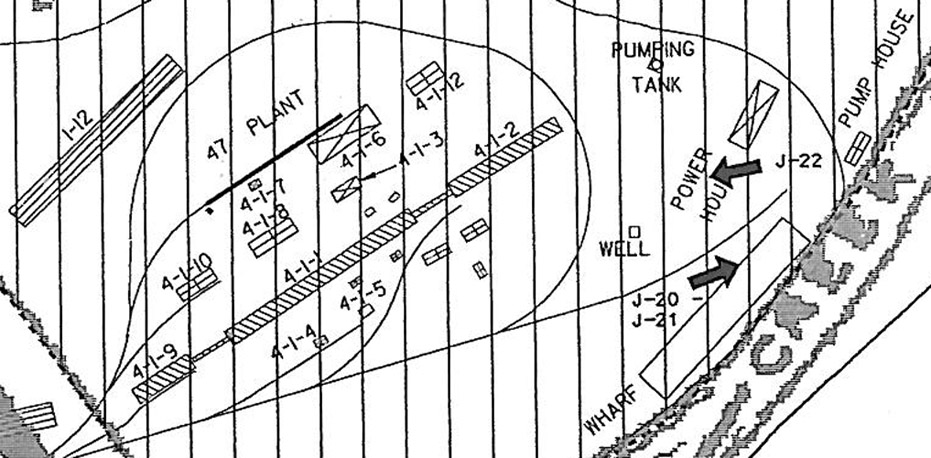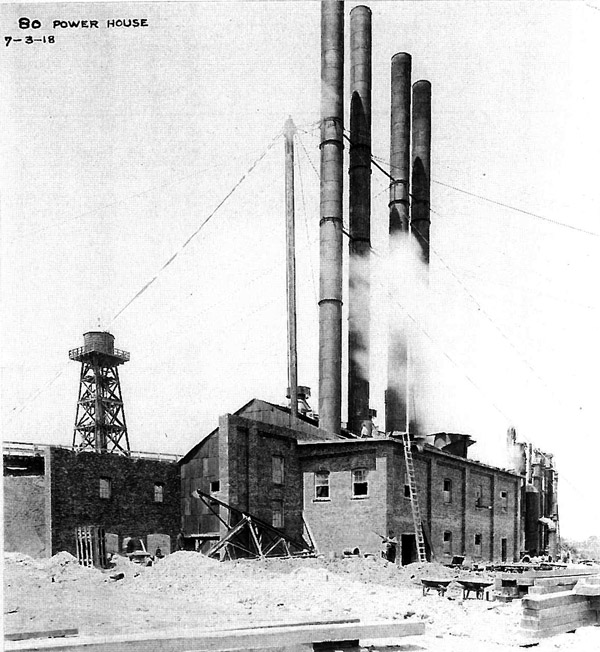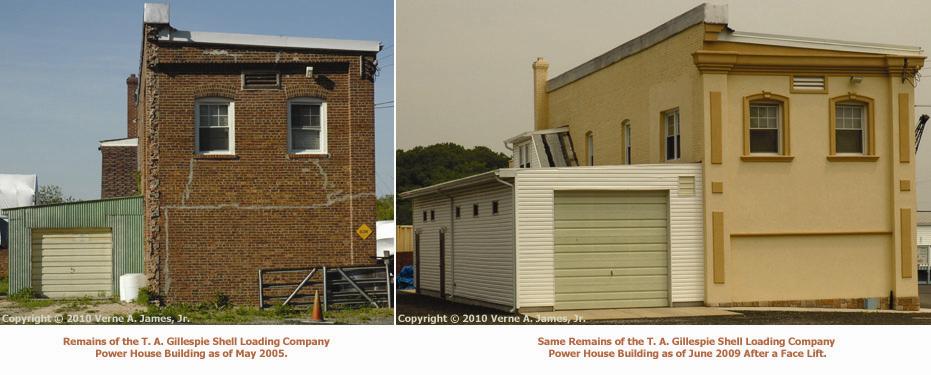Morgan Munitions – The T. A. Gillespie Loading Company Power House
While on a trip visiting Mom in Morgan back in 2005, I took a side trip to the place where the family of my childhood friend Rick kept their boat. When we were teenagers, we used to water ski on Cheesequake Creek and in Raritan Bay. One time one of our high school gym teachers, who we called “Meatball”, came along with us. That was a good trip and he was actually a pretty good water skier. Other times when we went in the bay we would stop right over the place where the sewage pipe emptied out into the bay much to the distaste of the person skiing who then sank into it.
Not knowing anything, and I mean anything, about the history of Cheesequake Creek at the time, I always wondered about all the pier pilings we saw on it while water skiing. It seemed that something big used to be there. During my 2005 visit to Brown’s Boat Yard, where Rick’s boat was (and still is) moored, I noted an old brick building and wondered if that had anything to do with the old munitions factory which people would mention on occasion. It looked like it was from the early 20th century and was previously part of a larger structure so I took a photo of it. On one side of the building, the unevenness of the brick endings looked like there used to be a longer brick wall.
In the early summer of 2009, my Jesse Selover Elementary School Phys Ed teacher, Mr. Baumann, was kind enough to provide me with some US Army Corps of Engineers diagrams showing where the buildings of the expansive T. A. Gillespie Loading Company were originally located. I have to say that this was an amazing thing to finally see since no one had ever seemed to have any idea of the plant’s layout or even exactly where it was located. I analyzed these diagrams for hours. Upon close examination of the diagrams, I noticed that the Power House and wharf were located where Brown’s Boat Yard has been since 1952. It occurred to me that perhaps the building I saw in 2005 might actually indeed have had something to do with the Power House.
Later that summer, I went back to look at the old brick building and saw that it had in the mean time had an extremely well done make over. My school buddy Ken and I walked around the building and examined the remains of the near by brick walls which appeared to be the walls of a prior larger building. We both concluded that this probably was actually the remains of the Power House. We were pleased to discover that it was composed of bricks from the Sayre & Fisher Brick Company previously located a few miles away in the northern part of Sayreville and once the largest brick manufacturer in the world.
Well at long last I located a photo, dated July 3, 1918, of a mostly and then recently constructed Power House. It also showed the elevated Pumping Tank in the background. If you compare the 1918 photo to the 2005 photo of the brick building at Brown’s Boat Yard, you will see that indeed that brick building was part of the T. A. Gillespie Loading Company’s Power House building. Some think this is the sole remaining structure from the T. A. Gillespie Loading Company but I believe there is one other building (see the “The Last Remaining Gillespie Buildings“). I used to have suspicions that were a few other buildings remaining but now I really don’t think so, just these two.

Diagram of the Portion of the T. A. Gillespie Loading Company Located Nearest to Cheesequake Creek. Source: US Army Corps of Engineers.
The Power House is located on the right side of the diagram above the arrow marked “J-22”. It is the rectangle with the big “X”. On the lower right is Cheesequake Creek and the wide gray segment in the bottom left corner is where the Garden State Parkway is today. This portion of the facility was known as Plant 47 and contained the Power House, the wharf on Cheesequake Creek, buildings making up some of the production lines for the loading of explosives into 75mm artillery shells (featured in some other to-be-reposted pages), railroad tracks connecting the facility, and the elevated Pumping Tank. I don’t yet have specifics on which portions of the facility utilized the Pumping Tank, i.e., whether it was used to supply water for steam or if it also supplied water for the shell loading production lines. Hopefully that will be determined in the near future. Today, of course, the remains of the Pumping House and the wharf area are occupied by Brown’s Boat Yard. Where the diagram shows buildings named with the prefix “4-1-“ is today a relatively new neighborhood located in the area to the east of the Garden State Parkway and circled by Gondek Drive. I remain very amused at one of the names of the streets which intersects Gondek Drive. How do you pronounce “Wlodarczyk”? It is so much easier now to get to Brown’s Boat yard since there are paved streets. When we went water skiing as kids, it was a hilly, long and dusty dirt road between Ernston Road and Brown’s Boat Yard.
Originally posted on June 26, 2010.


My great-grandfather, Lee Mark Seely, when registering for the WW I draft in a nearby locale, listed the T.A. Gillespie Loading Co., South Amboy, as his place of employment. This was September 12, 1918. Needless to say, a few weeks later, he was unemployed. In part of a subsequent letter, he stated that he was headed for Corning and his new job. He lived an adventurous life, riding the railroad from job to job until he settled at the Conestoga Valley Camp Association, West Earl Twp, Ephrata, PA as caretaker from its inception in 1933 to his death in 1958. God rest his soul. He is very much alive in my imagination.
Thanks for this informative post and your autobiographical narrative. You make history come alive.
Thank you for your info! Glad he wasn’t a casualty of the plant destruction otherwise you wouldn’t have responded (as you wouldn’t have been born). Interesting to think about those things in that way.
Hello. I recently came across a picture of my grandfather in uniform in front of a sign from “Camp Kearney”. I googled Camp Kearney and found that it is, and has always been, located in CA. This did not seem right as my grandfather was living in NY with a wife and 6 kids at the time. Through Ancestry.com, I found a copy of his WWI draft registration card which confused me more – not ever having heard of a military experience from him. I was additionally mystified to see that he had listed “T.A. Gillespi Loading Company” as his employer. So you have to know that when I read your comment above and saw that your great-grandfather had enlisted on Sept 12, 1918 – the same date as my grandfather enlisted – I had to contact you. Please, please any information you may wish to share will be greatly appreciated.
Thank you in advance, Judy Coleman
My great grandfather James A. Nelson was president and CEO of T. A. Gillespie and East Jersey Pipe Company until around 1920. The explosion was a tragedy. Oddly, my grandfather Robert Nelson, Sr. never spoke about the explosion. The only hint of a problem was that by 1919, most of that generation had moved to other states. My grandfather moved to Harrisburg, PA when my mother was 6 months old. It was in Harrisburg that he and his young family eagerly sought religious peace in the First Church of the Brethren in the city of Harrisburg. He sometimes spoke of the emotional aspect of his job designing ever more deadly mortar shells in WWI. His conversations always turned to his sense of guilt over the part he played in the deadly business of killing. He never reconciled with his father J. A. Nelson. Robert lived to almost 90 years of age. Late in life he and his wife Myra moved to N. Manchester, Indiana where they lived our their lives with their son Robert Nelson, Jr. Only after my grandparents deaths did I learn of the awful explosion that clearly effected my grandfather to his soul.
Thank you for sharing your family’s story with us. It was a devastating event to many, many people. Sadly, their stories very likely will be lost forever but should anyone have any more, please put them here.
Do you know the location of the loading pier where the May 19th 1950 explosion occurred?
This site has what you are looking for. You can see from the photos where the remains are located. http://pixbyninjuhtrixx.weebly.com/powder-pier.html
FYI History, 100 years later, the after effects of this massive explosion still litter this area, as a 40 yr former resident of Parlin, NJ, Sayreville’s Oak Tree East section off Ernston Rd, my former residents back then in the 70’s and 80’s, was littered with shrapnel all over my yard on Driftwood Dr, off Ernston Rd, by the water tower. As a frequent hunter and dirt bike rider back then, we used to venture down to the Global Land Fill area and Sand Pits, along the Morgan Creek all off Ernston Rd, which was the main access point to Brown’s Boat Yard and Marina, etc. We would find many intact 75 mm artillery shells littering the canals, sandpits, along the GSP Bridge that crosses the Morgan Creek, etc. In closing this was one heck of an explosion, residents today can easily find shrapnel and 75mm shells, but as a caution do not touch, disturb or attempt to move these relics, they could still go Booooomm!!!
I’m trying to solve a bit of mystery. The front page of the South Amboy Citizen on March 11, 1922 has an article reporting the death of one Francis Holton from the discharge of shell he was dismantling at the Morgan Ordance Depot. Does that mean that the Depot was still a working concern in 1922? Or were the shells still being dismantled at what was left of a defunct plant in the wake of the 1918 explosion? Either way, how long did these operations continue?
Hi Todd, Apparently the Morgan Ordnance Depot was still in operation when the event occurred. I don’t have info at my fingertips regarding when it ceased operations. Possibly the book “Explosion at Morgan” might have this info (I have the book but it is not at my location at the moment). Next time I’m at the other location, I’ll try to look it up in that book.
We moved in to oak tree east in 1967. I had 6 3 inch projectiles for years, that I managed to hide.
We new there had been an explosion. We did not know it was an EVENT.